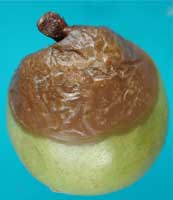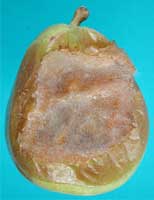ID Gallery: Mucor Rot
Mucor Rot of Apple and Pear
Mucor rot can cause significant losses of fruit, but is generally not a major problem, when good harvest management and water sanitation practices at packing are implemented.
For more information about mucor rot and it’s management visit our page Mucor Rot Postharvest Disease.
Click on images below to to full size.
Photo credits to Achour Amiri and Keith van den Broek, WSU TFREC, unless otherwise noted.
Mucor rot (Mucor piriformis) on a Golden Delicious apple showing very soft, juicy, decayed tissue with a sharp margin. Mucor rot decay often has a sweet odor. Photo: CL Xiao, USDA-ARS.
Cross section of Mucor rot on a Granny Smith apple. Note juicy-watery tissue and white sporangiophores emerging from the calyx-end.
Actively growing Mucor infection on Granny Smith apple under high humidity causing the emergence of fuzzy-white sporangiophores.
Early stage infection of Mucor rot starting from a wounded area around the stem-end on d’ Anjou pear. Photo: CL Xioa, USDA-ARS.
Advanced stage of Mucor rot originating from stem infection on a d’Anjou pear fruit; gray mycelium with dark sporangia. Photo: CL Xiao, USDA-ARS.
Stem-end Mucor infection carrying sporangiophores and black sporangia on Bartlett pear.
Advanced stage of Mucor rot on a d’Anjou pear fruit; gray mycelium with dark sporangia. Photo: CL Xiao, USDA-ARS.













